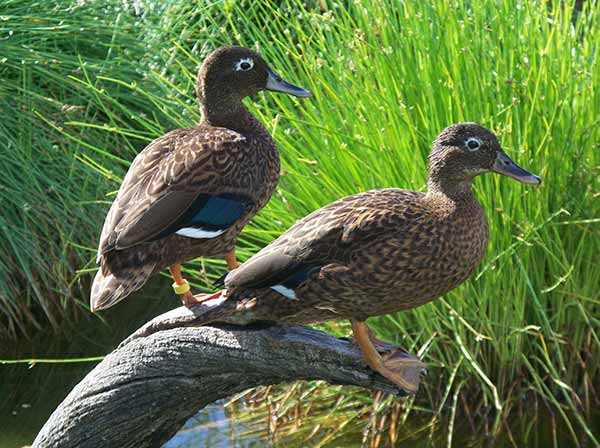Laysan Duck/Teal

Scientific Name
Anas laysanensis
Alternative Names
Laysan Duck, Laysan Teal
Measurements
| Feature | Male | Female |
|---|---|---|
| Length | 38–43 cm (15–17 in) | 38–43 cm (15–17 in) |
| Wingspan | 60–70 cm (24–28 in) | 60–70 cm (24–28 in) |
| Weight | 450–500 g (1.0–1.1 lb) | 400–450 g (0.9–1.0 lb) |
Status
Endemic to the Hawaiian Islands. Once widespread, now only found on Laysan Island and two atolls. Listed as Threatened under the U.S. Endangered Species Act after recovering from near-extinction.
Identification
A small, dark brown duck about the size of a teal. It has a white eye-ring and a short bill—greenish with black blotches in males, orange with black spots in females. Both sexes have an iridescent purplish-green wing patch. Older birds often show white feathers on the head and neck (leucism). Legs and feet are orange. They go through a full molt each year and cannot fly during that time.
Voice
Soft, raspy quacks. Females make a gentle series of quacks, while males produce a quiet, wheezy call. Alarm calls are sharp and short.
Diet
Feeds on brine flies, their larvae, aquatic insects, seeds, algae, small crustaceans, and plant material. Often shows unique “fly-snapping” behavior—running through swarms of flies and catching them mid-air with rapid bill movements.
Distribution
Currently found on Laysan Island, Midway Atoll, and Kure Atoll. Historically lived across most Hawaiian Islands.
Habitat
Shallow lakes, marsh edges, grasslands, and low shrubs. Prefers areas near freshwater ponds and thick vegetation for hiding.
Breeding
Pairing begins in autumn. They build their nests on the ground under thick grass or shrubs. Clutches usually contain 4 eggs, but more on Midway where food is richer. Ducklings feed themselves from day two but stay with the mother for 40–60 days.
Wintering
Non-migratory. Remains on islands year-round due to isolation and limited flight ability.
Conservation
Once reduced to only 12 birds in 1912 due to rabbits destroying vegetation and introduced predators. Rabbits were removed in 1923, and numbers slowly rose. In 2002–2005, birds were moved to Midway and Kure to create new populations. Still threatened by sea level rise, storms, disease, predators, and habitat loss. Now recorded as Threatened, not Endangered, due to successful recovery efforts.
